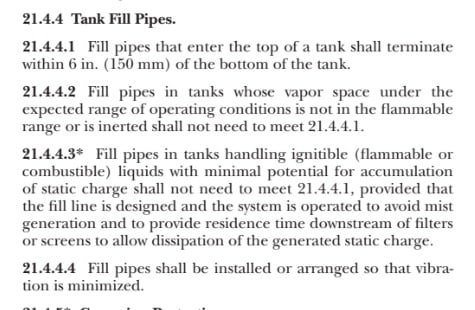Tank connections and fittings
118 Storage tank filling and emptying connections, and openings for dipping and venting, should be located at least 4 m from any source of ignition, building opening, trench or depression. Any drain in the vicinity should be either fitted with an interceptor or routed to an appropriate waste collection/treatment facility.
122 The end of the tank filling line should extend below the lowest normal operating level of the liquid to minimise the generation of static electricity from splash filling. To prevent siphoning, the line should be self draining. Where separate lines are used for filling and emptying, a liquid seal can be maintained by ending the discharge line at least 150 mm above the bottom of the filling line. To minimise the risk of tank leakage, it is preferable for lines to enter the tank at the top. This may not always be reasonably practicable, particularly for large vertical tanks, which are normally filled through a low-level nozzle.
123 All dip rods and tubes should be earthed and, where appropriate, an earthing lead for connection to a road tanker should be fitted. See PD IEC/TS 60079-32-1.
Dipping
138 Where gauging is done by dip rods, a suitable dip tube should be provided, with the dipping rod substantially smaller in diameter than the dip tube to minimise measurement errors. Dipping should not be done through open manholes.
139 Dipsticks are potential sources of ignition in that they may produce frictional heating or sparking, or static electricity. They should be made of non-sparking alloys and are earthed. Further guidance may be found in Energy Institute Model Code of Safe Practice Part 21: Guidelines for the control of hazards arising from static electricity.
140 Manual dipping is not as accurate as an automatic gauge but provides an adequate estimate of the contents. Each tank should have its own calibrated dipstick, not to be used for other tanks. It may be necessary to protect the bottom of the tank to avoid damage from repeated dipping.
141 Dipsticks for large tanks are difficult to handle. Dip tapes may be an alternative. They measure depth and are used with calibration tables for individual tanks.

